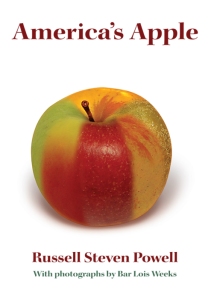

VERSATILE as apples are, I have not come across many recipes that combine them with the sweet spice cardamom. Though native to India, Guatemala is now the leading producer of cardamom, an unusual spice that is often featured in Scandinavian baked goods.
My fondness for cardamom dates back to childhood, when my mother made a braided Scandinavian coffee bread every Christmas flavored with this distinctive spice. She always made breads to give away in addition to the loaves inhaled by our family of six, to family, friends, even the postman and milkman some years.
The coffee bread was highly aromatic, moist, and chewy, and it came served with butter topped by a thin layer of almond extract-tinged icing decorated with candied cherries and finely chopped walnut pieces. But it was the cardamom that gave the bread its distinctive bite.
In making the recipe below I followed my mother’s method of peeling whole cardamom seeds from their whitish husks, and grinding them by hand with mortar and pestle to the consistency of coarse pepper. This worked to great effect in her bread — you could see little shards of cardamom bursting with intense cardamom flavor — and whole seeds kept in glass jars keep their flavor longer.
But the cardamom flavor in the cake I made was too mild using this technique, overshadowed by the pecans. I subsequently read that finely ground cardamom is the preferred consistency for most baked goods, infusing them with stronger cardamom flavor than the rougher mortar-and-pestle-crushed seeds.
This Scandinavian Apple Cake recipe was adapted from one given to my mother by Trish Leipold of Wolfeboro Falls, New Hampshire, years ago; my mother only recently passed it along to me.
I made a few mistakes in my first attempt, corrected here. Further chopping of the cubed apples will improve the cake’s texture and make it moister by releasing more of the apples’ juice. The apple’s skin, incidentally, included for nutritional purposes, adds flavor and color to the cake.
I used three McIntosh and two Golden Delicious apples. The cake is delicious, and definitely merits another try.
Scandinavian Apple Cake
1 c white flour
1 c whole wheat flour
2 t cinnamon
1 t baking powder
1 t baking soda
⅔ t ground allspice
¼ t ground cardamom
pinch of salt
5 medium-sized New England apples, cored and chopped
½ c sugar
1 c chopped pecans or walnuts
⅔ c butter, melted
2 eggs, slightly beaten
2 t vanilla
Preheat oven to 350°F. Grease a 9”x13” baking dish.
In large bowl, combine flours, baking powder, baking soda, and spices. Set aside.
In another large bowl, mix together apples, sugar, nuts, and butter. Using a food chopper or processor, make apple pieces about the size of peas. Stir in eggs and vanilla.
Add dry ingredients to apple mixture, stirring just until combined. Spread into prepared baking dish and bake for 30 minutes or until the apples are soft and a toothpick inserted in the cake comes clean.
***
THIS SUNDAY, November 23, from 10 a.m. to 11:30 a.m. author Russell Steven Powell will sample apples, answer questions, and sign copies of his new book, Apples of New England, at Tags Hardware in the Porter Square Shopping Center, 29 White St., Cambridge, Massachusetts.
 APPLES OF NEW ENGLAND (Countryman Press, 2014), a history of apple growing in New England, includes photographs and descriptions of more than 200 apple varieties discovered, grown, or sold in the region. Separate chapters feature the “fathers” of American wild apple, Massachusetts natives John Chapman (“Johnny Appleseed”) and Henry David Thorea; the contemporary orchard of the early 21st century; and rare apples, many of them photographed from the preservation orchard at Tower Hill Botanic Garden in Boylston, Massachusetts.
APPLES OF NEW ENGLAND (Countryman Press, 2014), a history of apple growing in New England, includes photographs and descriptions of more than 200 apple varieties discovered, grown, or sold in the region. Separate chapters feature the “fathers” of American wild apple, Massachusetts natives John Chapman (“Johnny Appleseed”) and Henry David Thorea; the contemporary orchard of the early 21st century; and rare apples, many of them photographed from the preservation orchard at Tower Hill Botanic Garden in Boylston, Massachusetts.
Powell is senior writer for the nonprofit New England Apple Association after serving as its executive director from 1998 to 2011. Photographer Bar Lois Weeks is the Association’s current executive director.
Available in bookstores everywhere.
 AMERICA’S APPLE, (Brook Hollow Press, 2012) Powell’s and Weeks’s first book, provides an in-depth look at how apples are grown, eaten, and marketed in America, with chapter on horticulture, John Chapman (aka Johnny Appleseed), heirloom apples, apples as food, apple drinks, food safety insects and disease, labor, current trends, and apple futures, with nearly 50 photographs from orchards around the country.
AMERICA’S APPLE, (Brook Hollow Press, 2012) Powell’s and Weeks’s first book, provides an in-depth look at how apples are grown, eaten, and marketed in America, with chapter on horticulture, John Chapman (aka Johnny Appleseed), heirloom apples, apples as food, apple drinks, food safety insects and disease, labor, current trends, and apple futures, with nearly 50 photographs from orchards around the country.
The hardcover version lists for $45.95 and includes a photographic index of 120 apple varieties cultivated in the United States. America’s Apple is also available in paperback, minus the photograph index, for $19.95, and as an ebook.
Available at numerous bookstores and orchards, and Silver Street Media, Amazon.com, Barnes and Noble, and other online sources. For quantity discounts, email newenglandapples@verizon.net.